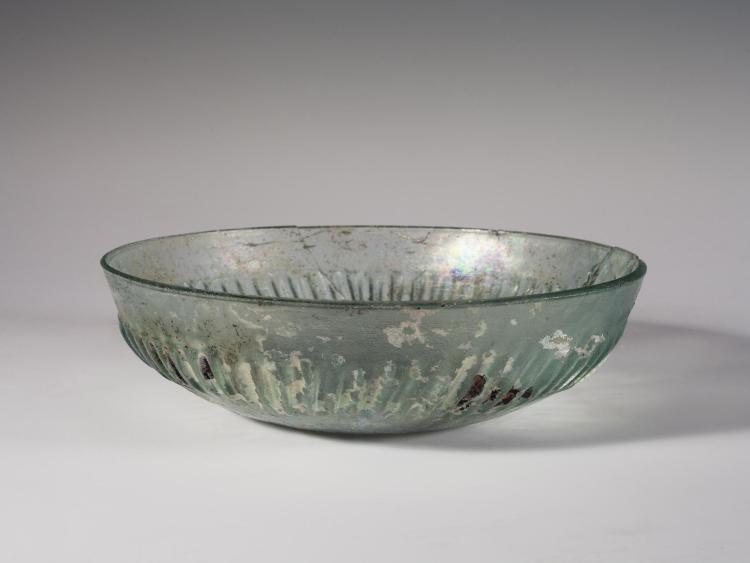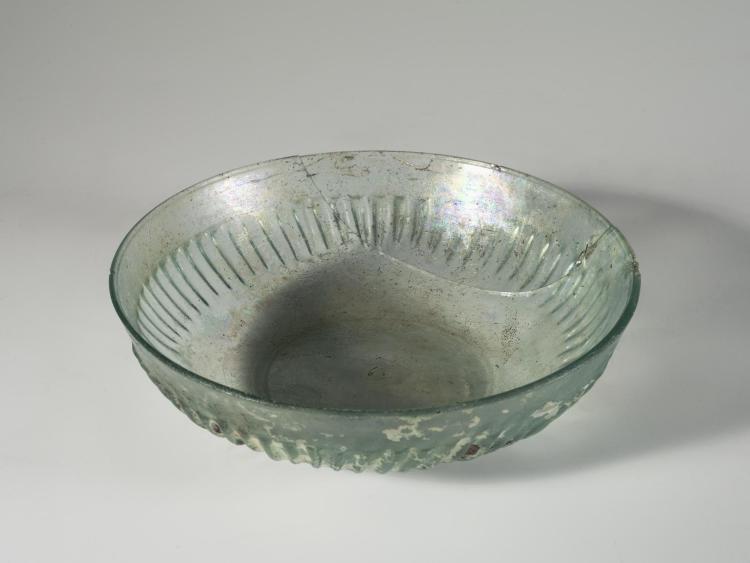2008.18.2.5, Roman Ribbed Bowl
Catalogue Entry 

From the Catalogue of Ancient Glass in the University of Colorado Museum
Gift of H. Medill Sarkisian and Justine Sarkisian Rodriguez (1979)
Transferred to CU Art Museum (2008)
Height: 4.8 cm
Diameter (max.): 17.8 cm
Roman, 1st century C.E.
Classification: Isings Form 3c; Harden Fabric 1
Description: Slightly outcurved rim on a wide bowl. 65 relatively evenly spaced ribs around center of bowl, reaching neither the lip nor the base. Colorless, almost transparent glass with green tint. Chip missing from rim. Some iridescence and a large rusty patch extending in an arc from the rim to the bottom. Sagged.
Comment: Not enough examples of this type come from an archaeological context to establish a definite chronology; a handful of fragments from the western provinces of the Roman Empire belong to the 1st century C.E. Other similar examples are Eisen 1927, pl. 40; Hayes 1975, no. 47; Fitzwilliam Museum 1978, no. 32c; Constable-Maxwell Collection 1979, lot 38; and Grose 1989, no. 234.
The shape of the rust damage indicates either a repair of a large break or that at one time the bowl was on display on a bad metal mounting, presumably propped up like a modern decorative plate.
Discussion 

This bowl was not blown or core-formed when shaped. Instead, it was formed by a process called "sagging" or "slumping." This involved a sheet of glass being heated until pliable, then placed over a dome-shaped mold, so that the edges would sag and slump down. The shape of the bowl was made while it sat upside-down. The edges were polished and flattened after the sagging was complete (1). Ribs like the ones seen on this bowl were slapped or carved into the glass (while still upside down) when the glass was still soft enough to be worked (2).
Romans valued colorless, clear glass more than colored and opaque glass. Colorless bowls and vases were significantly more expensive than their colorful counterparts. Manufacturing glass that did not have a lot of pigment required an extra ingredient. This ingredient was a neutralizing agent that would prevent the metals in the sand from tinting the glass (3). During the Flavian period of the Roman Empire (69-86 C.E.) Romans became obsessed with colorless glass objects, due to the popularity of cut rock crystal vessels. Clear, untinted glass resembled the very expensive crystal and therefore provided a cheaper alternative (4).
Footnotes
- Robert J. Charleston, Masterpieces of Glass: A World History from the Corning Museum of Glass (New York: Harry N. Abrams, Inc., 1980): 39-40.
- Donald B. Harden, Roman Glass from Karanis (Ann Arbor: University of Michigan Press, 1936): 19-20.
- Harden 1936: 6-9.
- E. Marianne Stern, Roman, Byzantine, and Early Medieval Glass (New York: Hatje Cantz Publishers, 2001): 130-131.
References
- Catalogue of the Constable-Maxwell Collection of Ancient Glass. London: Maggs Brothers, 1979.
- Eisen, G. A. Glass: Its Origin, History, Chronology, Technic and Classification to the Sixteenth Century, v. 1. New York: W. E. Rudge, 1927.
- Glass at the Fitzwilliam Museum. Cambridge: Cambridge University Press, 1978.
- Grose, D. F. Early Ancient Glass: Core-Formed, Rod-Formed, and Cast Vessels and Objects from the Late Bronze Age to the Early Roman Empire, 1600 B.C. to A.D. 50. New York: Hudson Hills Press, 1989.
- Hayes, J. W. Roman and Pre-Roman Glass in the Royal Ontario Museum. Toronto: 1975.

